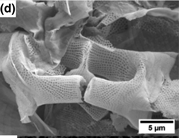Crossref Citations
This article has been cited by the following publications. This list is generated based on data provided by
Crossref.
Branco-Vieira, Monique
San Martin, Sergio
Agurto, Cristian
Freitas, Marcos A.V.
Mata, Teresa M.
Martins, António A.
and
Caetano, Nídia
2018.
Phaeodactylum tricornutum derived biosilica purification for energy applications.
Energy Procedia,
Vol. 153,
Issue. ,
p.
279.
Lomora, Mihai
Shumate, David
Rahman, Asrizal Abdul
and
Pandit, Abhay
2019.
Therapeutic Applications of Phytoplankton, with an Emphasis on Diatoms and Coccolithophores.
Advanced Therapeutics,
Vol. 2,
Issue. 2,
Pytlik, Nathalie
Klemmed, Benjamin
Machill, Susanne
Eychmüller, Alexander
and
Brunner, Eike
2019.
In vivo uptake of gold nanoparticles by the diatom Stephanopyxis turris.
Algal Research,
Vol. 39,
Issue. ,
p.
101447.
Kolbe, Felicitas
Daus, Fabian
Geyer, Armin
and
Brunner, Eike
2020.
Phosphate–Silica Interactions in Diatom Biosilica and Synthetic Composites Studied by Rotational Echo Double Resonance (REDOR) NMR Spectroscopy.
Langmuir,
Vol. 36,
Issue. 16,
p.
4332.
Azouz, Rania
2021.
Waste Recycling Technologies for Nanomaterials Manufacturing.
p.
671.
Lo Presti, Marco
Vona, Danilo
Ragni, Roberta
Cicco, Stefania R.
and
Farinola, Gianluca Maria
2021.
Perspectives on applications of nanomaterials from shelled plankton.
MRS Communications,
Vol. 11,
Issue. 3,
p.
213.
Shafiei, Nasrin
Nasrollahzadeh, Mahmoud
and
Iravani, Siavash
2021.
Green Synthesis of Silica and Silicon Nanoparticles and Their Biomedical and Catalytic Applications.
Comments on Inorganic Chemistry,
Vol. 41,
Issue. 6,
p.
317.
Krbečková, Veronika
Šimonová, Zuzana
Langer, Petr
Peikertová, Pavlína
Kutláková, Kateřina Mamulová
Thomasová, Barbora
and
Plachá, Daniela
2022.
Effective and reproducible biosynthesis of nanogold-composite catalyst for paracetamol oxidation.
Environmental Science and Pollution Research,
Vol. 29,
Issue. 58,
p.
87764.
El-Sheekh, Mostafa M.
Morsi, Hanaa H.
Hassan, Lamiaa H.S.
and
Ali, Sameh S.
2022.
The efficient role of algae as green factories for nanotechnology and their vital applications.
Microbiological Research,
Vol. 263,
Issue. ,
p.
127111.
Anand, Uttpal
Carpena, M.
Kowalska-Góralska, Monika
Garcia-Perez, P.
Sunita, Kumari
Bontempi, Elza
Dey, Abhijit
Prieto, Miguel A.
Proćków, Jarosław
and
Simal-Gandara, Jesus
2022.
Safer plant-based nanoparticles for combating antibiotic resistance in bacteria: A comprehensive review on its potential applications, recent advances, and future perspective.
Science of The Total Environment,
Vol. 821,
Issue. ,
p.
153472.
Paidi, Murali Krishna
Polisetti, Veerababu
Damarla, Krishnaiah
Singh, Puyam Sobhindro
Mandal, Subir Kumar
and
Ray, Paramita
2022.
3D Natural Mesoporous Biosilica-Embedded Polysulfone Made Ultrafiltration Membranes for Application in Separation Technology.
Polymers,
Vol. 14,
Issue. 9,
p.
1750.
Kausar, Ayesha
and
Ahmad, Ishaq
2023.
Degradable Green Polymers, Green Nanopolymers and Green Nanocomposites Derived from Natural Systems: Statistics and Headways.
Nano-Horizons,
Vol. 2,
Issue. ,
Kausar, Ayesha
and
Ahmad, Ishaq
2023.
Degradable Green Polymers, Green Nanopolymers and Green Nanocomposites Derived from Natural Systems: Statistics and Headways.
Nano-Horizons: Journal of Nanosciences and Nanotechnologies,
Vol. 2,
Issue. ,
Adhikary, Tathagata
Hossain, Chowdhury Mobaswar
and
Basak, Piyali
2023.
Bioinspired and Green Synthesis of Nanostructures.
p.
43.
Köhler, Lydia
Kaskel, Stefan
and
Brunner, Eike
2023.
Tailoring the Surface of Aluminum‐Enriched Diatom Biosilica .
Chemie Ingenieur Technik,
Vol. 95,
Issue. 11,
p.
1844.






